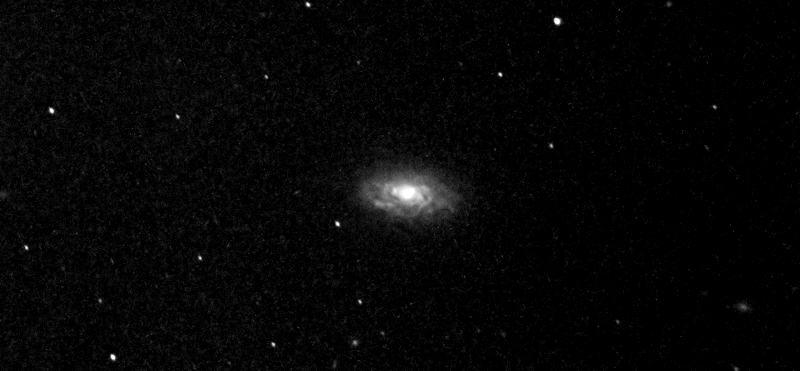Quail Family Visit, Planets, NGC4414 Galaxy, M57 Ring Nebula
Posted: 12 June 2015
Cloudy skies returned on Thursday, 4 June 2015. Received 0.04" rain on Friday, 5 June. Saturday, 6 June, was partly cloudy and windy during the daytime. Saturday evening I attended "Storytelling Sky Tour" at Oracle State Park. Report on the Oracle Dark Skies Committee web site. The sky was partly cloudy during most of the event and I did not open the observatory when I got back home.
Sunday, 7 June, was clear for most of the day but late in the afternoon the sky became mostly cloudy as moisture from what had been Hurricane Blanca in the Pacific made its way into southern Arizona. Received 0.51" rain during several brief rainshowers on Tuesday, 9 June. Cloudy skies continued until Thursday, 11 June.
|
Open: Thursday, 11 June 2015, 1859 MST Temperature: 90°F |
Session: 833 Conditions: Mostly clear |
1906 MST: viewed Venus, 83X, then Jupiter, 83X and 222X. Slewed back to Venus and viewed it at 222X. Just then a local Quail family arrived. Here you can see them leaving:

I then captured this image of Venus, iPhone 5s, handheld, afocal 222X, some digital zoom, cropped:

1924 MST: viewed Saturn, low in the southeast, 83X, a few minutes before sunset. It was faintly visible. 1935 MST: sunset. Slewed back to Jupiter. Two moons were visible: Ganymede and Io. Four minutes later the moon Callisto became visible. (Europa was behind the planet.) I captured this image of Jupiter, iPhone 5s, handheld, afocal 222X, some digital zoom, cropped:

Next, I prepared some accessories for the night's Deep Sky Object (DSO) imaging.
2000 MST: viewed Saturn, 222X. Two moons visible: Titan and Rhea. Captured this image of Saturn, iPhone 5s, handheld, afocal 222X, some digital zoom, cropped:

2010 MST: saw the first Kissing Bug of the night; terminated.
2014 MST: photographed the western sky with the D7200 DSLR to show the current configuration of Jupiter and Venus, D7200 DSLR handheld, f/5.6, 1/5sec, ISO 1600, FL 18mm:

Mouseover or tap on image for labels
When I stepped back inside the observatory I saw a 2nd Kissing Bug; terminated.
2020 MST: viewed Saturn, 222X. The moons Tethys and Dione were now visible but almost lost in the glare from the planet and ring system. Terminated the 3rd Kissing Bug. Then saw the 4th Kissing Bug and took a photo showing my hand to demonstrate how large Kissing Bugs are:

The bug was then terminated. That was followed by a 5th (and final) Kissing Bug of the night, which was also terminated.
2040 MST: viewed Saturn, 83X. Then viewed some DSOs, 83X: Omega Centauri (globular cluster), Centaurus A (galaxy), and NGC4414 (galaxy).
2052 MST: stepped outside of the observatory again to photograph the western sky, D7200 DSLR handheld, f/5.6, 1/2sec, ISO 12800, FL 18mm:

Mouseover or tap on image for labels
2055 MST: began setting up to image NGC4414. Mounted the D7200 DSLR at prime focus + extension on the 8" LX200-ACF using an off-axis guider (OAG). Did a focus test image on the star Spica using a Bahtinov Mask.
2126 MST: saw a nice meteor near the constellation of Corvus, moving west. There was a bright explosion at the end.
Found a faint guide star and did a framing test exposure of NGC4414. Framing was OK so did 5 and 10 minute, guided, ISO 12800, exposures. This is the 10 minute exposure, cropped:

2153 MST: completed NGC4414 imaging. Removed camera. Viewed Saturn, 83X and 222X. Nice view. Then viewed M57 (Ring Nebula), 222X. Began setting up for iPhone afocal imaging. This photo was taken with NightCap Pro (Long Exposure, Light Boost, 1/2sec, ISO 8000, 1 minute exposure) using the iPhone 5s, afocal 77X, mounted with the MX-1 Afocal Adapter:

2225 MST: began setting up to image M57 with the D7200 DSLR at prime focus + focal reducer + extension + OAG. Did a Bahtinov Mask focus test image on the star Vega. This is a slightly cropped, 60 second, ISO 6400, exposure of the Ring Nebula:

Found a good guide star and did guided 10 minute, ISO 6400/12800/25600, exposures of M57. My intention was to try to determine the limiting photographic magnitude at Cassiopeia Observatory using the D7200 DSLR. With my previous camera, a D7000 DSLR, I had determined that it was Magnitude +17.48 by photographing the Double Cluster. Before that, using a D70 DSLR, I had determined it to be Magnitude +16.84 using the area around M57. Unfortunately, I was not able to indentify stars that were fainter than +16.3 in the D7200 field-of-view with M57 using Voyager, SkySafari Pro, or Starry Night. Will try again when the Double Cluster is well-positioned for photography.
2322 MST: ended imaging. Took a sky quality reading using a Unihedron SQM-L meter. It was 21.30 this night. Submitted the reading to the Globe At Night site.
Then did some DSO observing, 83X: M57 (Ring Nebula), M22 (globular cluster), M4 (globular cluster), M20 (Trifid Nebula), M8 (Lagoon Nebula), and M17 (Swan Nebula). All were great views in the 8" telescope.
|
Close: Friday, 12 June 2015, 0000 MST Temperature: 70°F |
|
Comments are welcome using Email. If you are on Twitter you can use the button below to tweet this report to your followers. Thanks.
Cassiopeia Observatory Home Page
Copyright ©2015 Michael L. Weasner / mweasner@me.com
URL = http://www.weasner.com/co/Reports/2015/06/12/index.html
